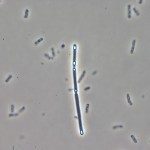Lien vers Pubmed [PMID] – 23239999
PLoS ONE 2012;7(12):e51047
We characterized a new quorum-sensing regulator, PlcRa, which is present in various members of the B. cereus group and identified a signaling heptapeptide for PlcRa activity: PapRa(7). We demonstrated that PlcRa is a 3D structural paralog of PlcR using sequence analysis and homology modeling. A comparison of the transcriptomes at the onset of stationary phase of a ΔplcRa mutant and the wild-type B. cereus ATCC 14579 strain showed that 68 genes were upregulated and 49 genes were downregulated in the ΔplcRa mutant strain (>3-fold change). Genes involved in the cysteine metabolism (putative CymR regulon) were downregulated in the ΔplcRa mutant strain. We focused on the gene with the largest difference in expression level between the two conditions, which encoded -AbrB2- a new regulator of the AbrB family. We demonstrated that purified PlcRa bound specifically to the abrB2 promoter in the presence of synthetic PapRa(7), in an electrophoretic mobility shift assay. We further showed that the AbrB2 regulator controlled the expression of the yrrT operon involved in methionine to cysteine conversion. We found that the ΔplcRa mutant strain was more sensitive to hydrogen peroxide- and disulfide-induced stresses than the wild type. When cystine was added to the culture of the ΔplcRa mutant, challenged with hydrogen peroxide, growth inhibition was abolished. In conclusion, we identified a new RNPP transcriptional regulator in B. cereus that activated the oxidative stress response and cysteine metabolism in transition state cells.

